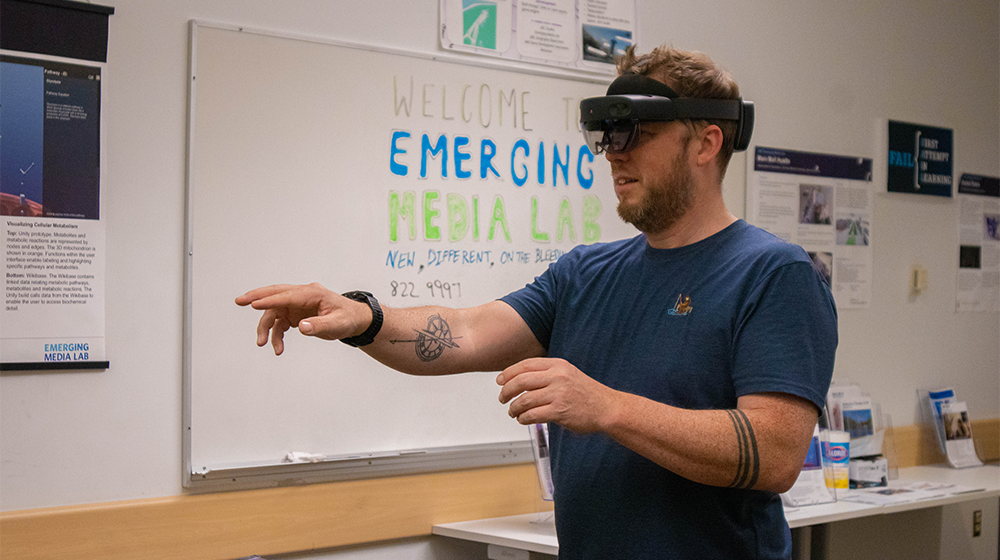In July, our guest editors are members of UBC’s Emerging Media Lab, a space where the UBC teaching and learning community can experiment with upcoming technological tools to share knowledge in a way that improves current learning approaches. Members of the Emerging Media Lab are Maryann Kempthorne, Saeed Dyanatkar, and Frederik Svendsen.
Emerging Media Lab
Emerging Media Lab (EML) at UBC is an experimental space where faculty, students, and staff collaborate with industry and the community to develop emerging technologies solutions that address research and learning problems. With two annual calls for proposals in July and March and year-round project development teams, EML works widely across campus. Since its opening in 2017, EML has developed 45 projects with 24 Principal Investigators. Faculty on the UBC Vancouver campus are welcome to bring ideas and challenges to EML. Faculty working with EML get support to connect technological solutions to their ideas and inspirational approach to problems that need solving.
EML is a platform-agnostic innovation incubator that works with agile methods to develop open-source projects using technologies like artificial intelligence (AI), virtual reality (VR), augmented reality (AR), data visualization and more. EML documents its processes to generate knowledge bases and shares outcomes of each investigation with the UBC community, local stakeholders and around the world.
Below is a small presentation of some of the Summer 2023 EML projects the team is supporting throughout UBC Vancouver, ranging from Law, Psychology, Biochemistry, Physiotherapy, and Theatre & Film.
Teaching various assessment techniques for the inner ear through mixed and augmented reality – Vestibular Assessment

Background
The vestibular system contains three fluid-filled canals that crystals can fall into, which can cause benign paroxysmal position vertigo (BPPV). Various assessment techniques that involve rolling the head into different positions can relocate the crystals and help to treat this problem. However, teaching students these techniques can be challenging due to a lack of resources to help visualize and understand the crystal movement as the maneuvers are being conducted.
Objective
The objective of this project – designed with the UBC Department of Physical Therapy – is to develop an AR teaching tool that can enhance instructor demonstrations of the various assessment techniques used to treat BPPV. By creating a 3D interactive model with the vestibular system superimposed onto a head, students can better observe and understand how the crystals move as the instructor performs the maneuver using the model.
Other Emerging Media Lab ongoing projects

Helping first-year law students overcome courtroom stress – Judicial Interrogatory Simulator (JIS)
For first-year law students, practicing their speech and argument is an important – and often stressful – part of their learning experience. This project from UBC Peter A. Allard School of Law combines VR and AI language tools to simulate both the judge and courtroom and help students practice delivering their argument and responding to questions from the judges.
Designing a novel way to display and understand the metabolic network – 3D Metabolism
The metabolic network is a famously difficult to learn model in the wider subject of metabolism, where the reactions that work together to produce metabolites are described as a pathway of lines and dots. This project from UBC Biochemistry and Molecular Biology provides a novel way to visualize this information to make it easier to consume and understand for students. A novel way to visualize the information contained in a metabolic network to make it easier to consume and understand.
Reimagining some of Shakespeare’s characters across technological media – Shakespeare XR
This project from UBC Theatre and Film shines a light on Shakespeare’s lesser known characters through AR, VR and an interactive touch table to explore the recently acquired First Folio.
Using machine learning to generate a web of interconnected content – Tapestry Tool
Tapestry Tool is an open-source online learning platform that allows users to collaborate in the development of interactive, associative, and multi-modal content. Currently generated manually, this project from UBC Department of Psychology looks to use machine learning to automatically generate tapestries based on a given topic.
These projects presented are but a small sample of what EML can do to help instructors address real-life problems through digital solutions. Discover more projects on the EML website.
Do you have a project that involves emerging technology in your classroom? We would love to hear from you!

